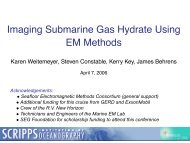The feasibility of reservoir monitoring using time-lapse marine CSEM
The feasibility of reservoir monitoring using time-lapse marine CSEM
The feasibility of reservoir monitoring using time-lapse marine CSEM
You also want an ePaper? Increase the reach of your titles
YUMPU automatically turns print PDFs into web optimized ePapers that Google loves.
F26<br />
Orange et al.<br />
er. <strong>The</strong> maximum anomaly is on the order <strong>of</strong> 2–4%, with the largest<br />
anomaly on the B x component. For each component, the anomaly<br />
onset occurs at or near the left edge <strong>of</strong> the <strong>reservoir</strong> assembly, coincident<br />
with flooding from the left.<br />
Partial-depletion effects<br />
Given current extraction efficiencies, it is likely that a significant<br />
residue <strong>of</strong> hydrocarbons will remain in the flooded section <strong>of</strong> the <strong>reservoir</strong>,<br />
and it is important to consider the impact this may have on<br />
<strong>time</strong>-<strong>lapse</strong> <strong>CSEM</strong>. Consider the case where the production engineer<br />
states that 20% volume <strong>of</strong> the <strong>reservoir</strong> has been extracted. Figure 8<br />
shows five variations <strong>of</strong> left flooding for this scenario, where the<br />
width <strong>of</strong> the flooded section depends on the fraction <strong>of</strong> hydrocarbons<br />
remaining in place. ModelAis for complete extraction 100% depletion,<br />
as used for the previous studies shown here. Models B-E show<br />
a varying percentage <strong>of</strong> depletion in the flooded section 80–20%.<br />
<strong>The</strong> resistivity <strong>of</strong> the partially depleted section is computed as a<br />
function <strong>of</strong> the pore space occupied by water <strong>using</strong> Archie’s law: <br />
f d 2 , where the water resistivity f 0.16 ohm-m, the porosity<br />
40%, and d is the <strong>reservoir</strong>-depletion factor.<br />
Figure 9 shows the <strong>CSEM</strong> anomalies for these scenarios. ModelA<br />
100% depletion shows the largest anomaly; model D 40% depletion<br />
shows the weakest anomaly. <strong>The</strong>se end members’ anomalies<br />
are about 10% different for the E y component and 30% different for<br />
the E z and B x components. Models A-D all have relatively low resistivity<br />
in the flooded section; hence, the anomalies correlate largely<br />
with the size <strong>of</strong> the unflooded <strong>reservoir</strong> section. Model E reverses the<br />
decreasing anomaly trend and exhibits a larger anomaly than model<br />
D. However, this is easily explained because model E has more remaining<br />
oil in place in the flooded section i.e., the entire <strong>reservoir</strong><br />
and hence has a much higher resistivity than model D.<br />
<strong>The</strong> difference in anomalies between any <strong>of</strong> these models is at<br />
least a few percent, suggesting that exploration or <strong>time</strong>-<strong>lapse</strong> <strong>CSEM</strong><br />
could be used to discriminate between varying degrees <strong>of</strong> <strong>reservoir</strong><br />
Depletion<br />
A: 100% 1 ohm-m<br />
B:<br />
1km<br />
80% 1.6 ohm-m<br />
C: 60%<br />
D: 40%<br />
E: 20%<br />
5 km<br />
100 ohm-m<br />
4km<br />
100 ohm-m<br />
1.25 km 3.75 km<br />
2.8 ohm-m<br />
100 ohm-m<br />
1.67 km 3.33 km<br />
6.2 ohm-m<br />
100 ohm-m<br />
2.5 km 2.5 km<br />
25 ohm-m<br />
5 km<br />
Figure 8. Five <strong>reservoir</strong> models representing 20% recovery <strong>of</strong> the<br />
original <strong>reservoir</strong> volume caused by flooding from the left. Models<br />
A–E show decreasing levels <strong>of</strong> depletion in the flooded region.<br />
100 m<br />
saturation. Furthermore, there is at least a 25% difference in anomaly<br />
size between any <strong>of</strong> these models and the 0% extraction i.e., 0%<br />
flooded models shown in the left column <strong>of</strong> Figure 3, indicating that<br />
all <strong>of</strong> these scenarios produce measureable <strong>time</strong>-<strong>lapse</strong> signals.<br />
We have presented variations for only a few model parameters;<br />
clearly, this work could be expanded to study the effects <strong>of</strong> frequency,<br />
depth <strong>of</strong> <strong>reservoir</strong> burial, <strong>reservoir</strong> thickness, variable background<br />
resistivity, resistivity contrasts, and the multiple receiver locations<br />
typical <strong>of</strong> <strong>CSEM</strong> field surveys. However, the results presented<br />
here are representative based on many other 2D computations we<br />
have made.<br />
a)<br />
Anomaly (ratio)<br />
2<br />
1.8<br />
1.6<br />
1.4<br />
1.2<br />
1<br />
b) 4<br />
Anomaly (ratio)<br />
c)<br />
Anomaly (ratio)<br />
A<br />
B<br />
C<br />
D<br />
E<br />
0.8<br />
−5 0 5 10 15<br />
3.5<br />
3<br />
2.5<br />
2<br />
1.5<br />
1<br />
0.5<br />
−5 0 5 10 15<br />
4.5<br />
4<br />
3.5<br />
3<br />
2.5<br />
2<br />
1.5<br />
1<br />
0.5<br />
−5 0 5 10 15<br />
Transmitter position along y (km)<br />
Figure 9. Anomaly ratios for the five partial-depletion models shown<br />
in Figure 8.Anomalies are computed by normalizing by a half-space<br />
response. <strong>The</strong> a inline electric field E y , b vertical electric field E z ,<br />
and c azimuthal magnetic field B x .<br />
Downloaded 10 Apr 2009 to 132.239.153.24. Redistribution subject to SEG license or copyright; see Terms <strong>of</strong> Use at http://segdl.org/




